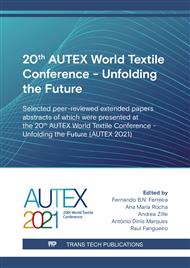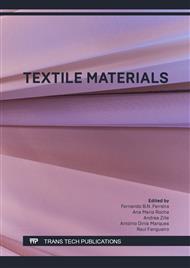[1]
C. Hertleer, L. Van Langenhove, Smart textiles: from prototype to commercial product, Autex World Conference, Ljubljana, Slovenia (2016).
Google Scholar
[2]
E. Lempa, M. Rabe, L. Van Langenhove, Coating and digital printing electrically conductive paths on textiles under consideration of percolation threshold, Progress Symposium, Bursa, Turkey (2019).
Google Scholar
[3]
M. Wagih, Direct-Write Dispenser Printing for Rapid Antenna Prototyping on Thin Flexible Substrates, 14th European Conference on Antennas and Propagation (EuCAP) (2020) 1-4, Information on: https://doi.org/10.23919/EuCAP48036.2020.9135625.
DOI: 10.23919/eucap48036.2020.9135625
Google Scholar
[4]
Y. Wei, X. Wang, R. Torah, J. Tudor, Dispenser printing of electrochromic display on textiles for creative applications, Electronics Letters. 53 (2017) 779-781. Information on: https://doi.org/10.1049/el.2017.0119.
DOI: 10.1049/el.2017.0119
Google Scholar
[5]
T. Greig, R. Torah, K. Yang, Investigation of the Effects of Ink Pigmentation on Substrate Profiling for E-Textile Dispenser Printing, IEEE International Conference on Flexible and Printable Sensors and Systems (FLEPS). (2021) 1-4. Information on: https://doi.org/10.1109/FLEPS51544.2021.9469756.
DOI: 10.1109/fleps51544.2021.9469756
Google Scholar
[6]
L. Hyosang et al, Dispenser printing of piezo-resistive nanocomposite on woven elastic fabric and hysteresis compensation for skin-mountable stretch sensing, Smart Mater. Struct. 27 (2018) 025017.
DOI: 10.1088/1361-665x/aaa5e3
Google Scholar
[7]
T. Greig, R. Torah, K. Yang, Investigation of Nozzle Height Control to Improve Dispenser Printing of E-Textiles. Proceedings. 68 (2021) 6. Information on: https://doi.org/10.3390/proceedings2021068006.
DOI: 10.3390/proceedings2021068006
Google Scholar
[8]
M. Rabe et al., Entwicklung selektiv wirksamer Adsorbertextilien zur Entfernung organischer Verbindungen aus Trinkwasser, Man made fibres congress, Dornbirn, Austria (2013).
Google Scholar
[9]
F. Gubbels et al., Selective Localization of Carbon Black in Immiscible Polymer Blends: A useful tool to design electrical conductive composites, Macromolecules. 27 (1994) 1972-1974.
DOI: 10.1021/ma00085a049
Google Scholar
[10]
W. Bobeth, Textile Faserstoffe, Beschaffenheit und Eigenschaften, Springer Verlag, Berlin (1993) S. 302-307.
Google Scholar
[11]
M. Rabe, Funktionalisierung als Plattform zur Erzeugung innovativer Technischer Textilien. Habilitationsschrift, TU Dresden (2017) S. 115. ISBN: 978-3-95908-104-7.
Google Scholar
[12]
D. Stauffer, Scaling theory of percolation clusters, Physics Reports. 54 (1979) 1-74.
DOI: 10.1016/0370-1573(79)90060-7
Google Scholar
[13]
Y. Mamunya et al., Electrical and thermal conductivity of polymers filled with metal powders, European Polymer Journal. 38 (2002) 1887-1897.
DOI: 10.1016/s0014-3057(02)00064-2
Google Scholar
[14]
W. Rehnby et al., Coating of textile fabrics with conductive polymers for smart textile applications (Published Conference Proceedings style), in Proc. Ambience'08 Conf., Boras, Sweden (2008).
Google Scholar
[15]
K. Kalaitzidou et al., A Route for Polymer Nanocomposites with Engineered Electrical Conductivity and Percolation Threshold, Materials. 3 (2010) 1089-1103.
DOI: 10.3390/ma3021089
Google Scholar
[16]
I. Chodak, I Krupa Percolation effect and mechanical behavior of carbon black filled Polyethylene,, Journal of Materials Science Letters, 18 (1999) 1457-1459.
Google Scholar
[17]
M. Akerfeldt et.al, Electrically conductive textile coating with a PEDOT-PSS dispersion and a polyurethane binder, Textile Research Journal. 83 (2013) 618-627.
DOI: 10.1177/0040517512444330
Google Scholar
[18]
E. Lempa et al. Electrically conductive textiles under consideration of percolation threshold and polymer crystallinity,, AUTEX Gent, Belgium, Conference Proceedings (2019).
Google Scholar



